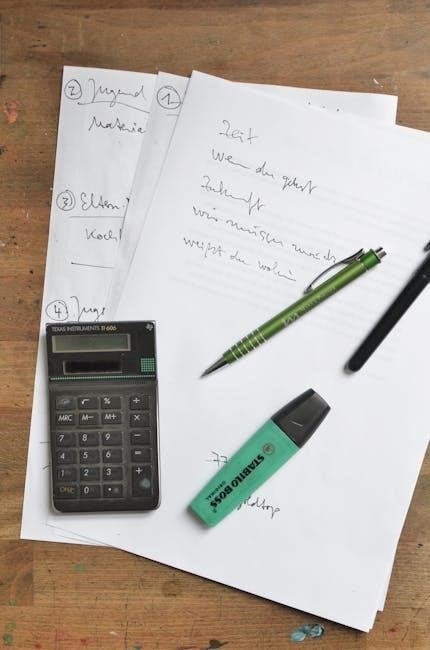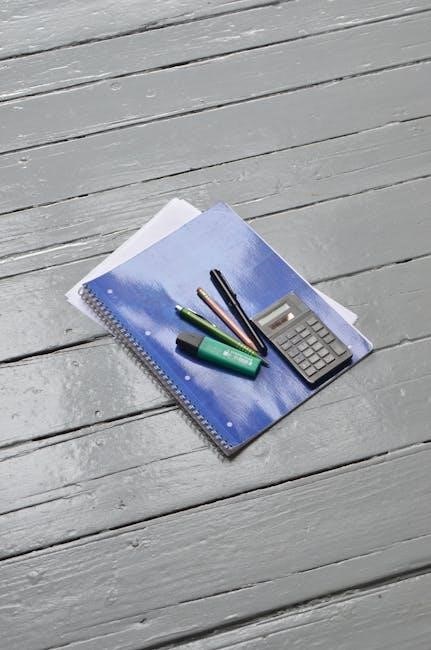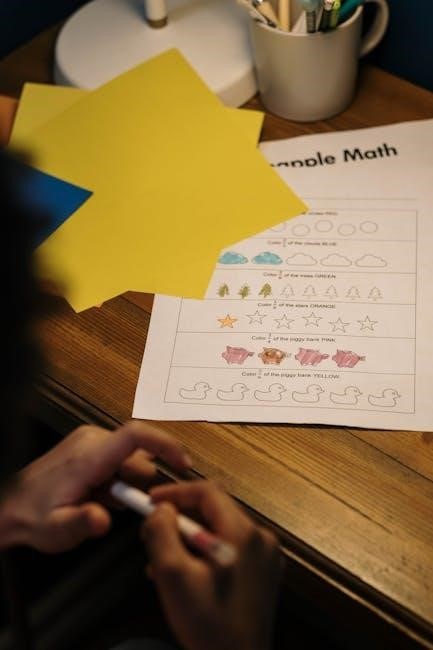These worksheets help kids learn number writing, counting, and recognition through tracing and matching activities, making learning interactive and engaging for young students.
1.1 What Are Count and Write Worksheets?

Count and write worksheets are educational tools designed to help young learners practice number tracing, counting, and writing skills. These worksheets typically feature numbers from 1 to 20, presented in various fonts and styles to enhance recognition. Activities include tracing numbers, counting objects, and writing corresponding numbers, making learning interactive and engaging. They are ideal for developing fine motor skills, number recognition, and understanding the relationship between numbers and quantities. These worksheets are widely used in early childhood education to provide a fun and structured way to master foundational math concepts.
1.2 Importance of Using Worksheets for Learning Numbers
Using count and write worksheets is essential for developing foundational math skills in young learners. These tools help improve number recognition, tracing, and counting abilities, while also enhancing fine motor skills through structured activities. Worksheets provide a clear and engaging way for children to understand the relationship between numbers and quantities, making learning interactive and enjoyable. They also serve as a practical resource for parents and educators to assess progress and reinforce math concepts in a structured manner, ensuring a strong academic foundation for future learning.

Benefits of Count and Write Worksheets 1-20 PDF
These worksheets enhance number recognition, tracing, and counting skills while improving fine motor abilities. They foster a strong math foundation and make learning numbers engaging and effective for children.
2.1 Developing Fine Motor Skills Through Tracing
Tracing numbers on worksheets helps children develop fine motor skills by practicing precise hand movements. This activity strengthens hand-eye coordination and dexterity, essential for writing and drawing. Regular tracing exercises improve grip control and finger accuracy, laying the foundation for neat handwriting. Worksheets featuring numbers in various fonts also expose kids to different letterforms, enhancing their ability to recognize and replicate shapes. Over time, tracing builds muscle memory, making writing less strenuous and more automatic, which is crucial for academic success in later years.
2.2 Understanding the Relationship Between Numbers and Quantities
Count and write worksheets help children connect numbers to real-world quantities, fostering a deeper understanding of numerical concepts. Activities like matching numbers to groups of objects or counting items before writing the corresponding number bridge the gap between abstract digits and tangible amounts. This visual and interactive approach ensures kids grasp that numbers represent specific quantities, enhancing their ability to count accurately and solve basic math problems. By linking numbers to objects, these worksheets build a strong foundation for understanding cardinality and numerical relationships.
2.3 Enhancing Counting and Number Recognition Skills
Count and write worksheets are designed to improve children’s ability to recognize and identify numbers from 1 to 20. Through interactive exercises, kids practice counting objects and writing the corresponding numbers, reinforcing their understanding of numerical order. Repetitive tracing and writing activities help refine their recognition of number shapes and patterns. These worksheets also introduce numbers in various fonts and styles, preparing students to identify them in different contexts. By linking counting to writing, these tools build a solid foundation for math skills and early literacy development, ensuring kids can confidently recognize and work with numbers up to 20.

2.4 Building a Strong Foundation for Math Concepts
Count and write worksheets lay the groundwork for essential math skills by introducing children to basic number concepts. Tracing and writing numbers from 1 to 20 helps develop familiarity with numerical symbols, while counting exercises build an understanding of quantity and sequence. These activities also introduce problem-solving through matching numbers to objects, fostering logical thinking. By mastering these fundamentals, children gain confidence in their ability to tackle more complex math concepts, such as addition and subtraction, in the future. This foundation is critical for long-term academic success in mathematics.

Key Activities in Count and Write Worksheets 1-20 PDF
Activities include tracing numbers, counting objects, matching numbers to quantities, and writing numbers in various fonts, promoting a comprehensive learning experience for young students.
3.1 Tracing Numbers from 1 to 20
Tracing numbers from 1 to 20 helps children develop fine motor skills and number recognition. Worksheets feature numbers in various fonts, allowing kids to practice writing accurately. This activity builds confidence in forming digits correctly and reinforces number-quantity associations. Tracing also introduces children to the concept of writing numbers in different styles, preparing them for diverse handwriting experiences. Regular practice improves dexterity and familiarity with numerals, laying a strong foundation for counting, writing, and understanding math concepts. It’s an engaging way to make learning numbers fun and effective for young learners.
3.2 Counting Objects and Writing Corresponding Numbers
Counting objects and writing the corresponding numbers is a practical way to enhance counting skills and number recall. Worksheets often feature sets of objects, such as shapes or animals, for children to count and then write the correct number. This activity strengthens the connection between numbers and their real-world applications, helping kids understand quantity and cardinality. It also reinforces number formation and recognition, making it easier for children to apply these skills in everyday situations and build a strong foundation for math concepts.
3.3 Matching Numbers to Their Quantities
Matching numbers to their quantities is an essential skill that reinforces the relationship between numerals and groups of objects. Worksheets often include interactive exercises where students match numbers 1-20 to corresponding groups of items, such as dots, shapes, or animals. This activity helps children understand quantity representation, enhancing their ability to connect numbers with real-world objects. By practicing this skill, students improve number recognition and quantification, building a solid foundation for math and problem-solving abilities. It also promotes visual recognition and memory of numbers, making learning engaging and effective.
3.4 Writing Numbers in Various Fonts and Styles
Writing numbers in different fonts and styles helps children recognize and reproduce numerals accurately. Worksheets often feature numbers in bold, italic, and cursive styles to expose kids to diverse lettering. This activity enhances fine motor skills and hand-eye coordination while familiarizing them with how numbers appear in various contexts. By practicing number writing in multiple formats, students develop consistency and confidence in their handwriting. Additionally, this exercise prepares them for reading numbers in different fonts, making their number recognition skills more versatile and adaptable to real-world scenarios.

How to Use Count and Write Worksheets Effectively
Use count and write worksheets effectively with a step-by-step guide for parents and educators. Incorporate practical tips and interactive exercises to engage children and enhance learning outcomes.
4.1 Step-by-Step Guide for Parents and Educators
Start by introducing one worksheet at a time, ensuring children focus on tracing and writing numbers accurately. Guide them in counting objects and matching numbers to quantities. Provide clear instructions and demonstrations. Encourage repetition for better retention. Offer positive feedback and correct mistakes gently. Make learning interactive by incorporating games or rewards. Monitor progress and adjust activities based on individual needs. This structured approach helps reinforce number recognition and counting skills effectively.
4.2 Incorporating Worksheets into Daily Learning Routines
Set aside a specific time each day for worksheet activities, such as 10-15 minutes. Begin with tracing numbers to improve fine motor skills and number recognition. Gradually introduce counting and matching exercises to connect numbers with quantities. Consistency is key to building a strong foundation in number sense. Make it a habit to review and practice regularly, ensuring a smooth transition from tracing to independent writing. This structured approach helps reinforce learning and makes math concepts enjoyable for young learners.
4.3 Making Learning Fun with Interactive Exercises
Incorporate games, puzzles, and group activities to make learning numbers engaging. Use colorful worksheets with images or objects for students to count and write corresponding numbers. Add interactive elements like mazes or bingo games that involve counting and number recognition. Reward systems, such as stickers, can motivate participation. Rotate activities weekly to maintain interest and prevent boredom. These exercises not only enhance number sense but also foster a love for learning in a playful environment.

Downloading and Accessing Count and Write Worksheets 1-20 PDF
Free count and write worksheets are widely available online. Popular educational websites offer downloadable PDFs perfect for teaching number recognition and tracing. Use these resources to enhance learning effectively.
5.1 Free Resources Available Online
Free count and write worksheets 1-20 PDF are widely available online, offering a variety of activities like tracing, counting, and matching. Websites such as Planes & Balloons and K5 Learning provide downloadable resources designed to help children practice number writing, counting, and recognition. These worksheets often feature engaging layouts and interactive exercises, making learning fun for kids. Parents and educators can easily access these materials to support early math skills development. Free PDF downloads ensure convenience and accessibility for everyone.
5.2 Popular Websites for PDF Downloads
Websites like Planes & Balloons and K5 Learning offer a wide range of free count and write worksheets 1-20 PDF. These platforms provide interactive exercises, tracing activities, and counting games designed for young learners. Other popular sites include Teachers Pay Teachers, which offers diverse worksheet styles, and Reading & Math for K-5, catering to early childhood education. These resources are easily downloadable, ensuring parents and educators can access high-quality materials to support math skills development in a fun and engaging way.
5.3 Tips for Finding High-Quality Worksheets
To find high-quality count and write worksheets 1-20 PDF, ensure they have clear layouts and age-appropriate content. Look for worksheets with interactive elements like tracing, counting, and matching activities. Check for reviews or ratings from other users to gauge effectiveness. Opt for worksheets that include examples or additional resources for practice. Ensure the content aligns with educational standards and curriculum goals. Customizable options are a bonus, allowing adaptation to individual learning needs. High-quality worksheets should be visually appealing, easy to understand, and engaging for young learners.

Aligning Worksheets with Educational Standards
Count and write worksheets 1-20 PDF align with educational standards by providing structured activities that support foundational math skills and curriculum goals for early learners through interactive tracing, counting, and number recognition exercises.
6.1 Meeting Curriculum Goals for Early Childhood Education
Count and write worksheets 1-20 PDF are designed to meet early childhood education standards by focusing on foundational math skills. They include tracing activities to develop fine motor skills, counting exercises to understand quantities, and number recognition tasks. These worksheets align with curriculum goals by providing structured practice for young learners, ensuring they grasp basic math concepts. Interactive exercises, such as matching numbers to objects, help students connect counting to cardinality, preparing them for advanced math skills while fostering a strong educational foundation.
6.2 Developing Problem-Solving Skills Through Counting
Count and write worksheets 1-20 PDF enhance problem-solving skills by engaging students in counting exercises and number recognition. Activities such as tracing, counting objects, and matching numbers to quantities help children understand relationships between numbers. These tasks encourage logical thinking and methodical approaches to solving math problems. By practicing counting and connecting it to real-world scenarios, students develop the ability to tackle basic arithmetic challenges confidently, laying a strong foundation for more complex math concepts in the future.
6.3 Preparing Students for Higher Math Concepts
Count and write worksheets 1-20 PDF lay the groundwork for higher math skills by fostering a strong understanding of number relationships. Activities like tracing, counting objects, and matching numbers to quantities help students grasp foundational concepts. These exercises build critical thinking and logical reasoning, essential for tackling addition, subtraction, and sequencing. By mastering counting and number recognition, students develop the confidence and skills needed to approach more complex math operations with ease, ensuring a smooth transition to advanced mathematical ideas.

Tips for Effective Use of Count and Write Worksheets
To maximize learning, use interactive exercises, provide immediate feedback, and encourage self-correction. Incorporate these worksheets into daily routines for consistent practice and skill reinforcement.
7.1 Encouraging Interactive Learning
Interactive learning enhances engagement and understanding. Use tracing, coloring, and matching games to make counting and writing fun. Incorporate real-world examples, like counting objects at home, to connect learning with daily life. Encourage students to use manipulatives or digital tools for hands-on practice. Pair worksheets with verbal exercises, such as calling out numbers and having students identify or write them. Group activities, like counting games, foster collaboration and excitement. By integrating play and creativity, learning becomes enjoyable and effective, helping students develop a strong foundation in number skills. Consistency and positive reinforcement are key to successful outcomes.
7.2 Providing Immediate Feedback and Correction
Immediate feedback is crucial for effective learning. Review worksheets promptly to correct mistakes and clarify doubts. Use visual aids or verbal explanations to ensure understanding. Highlight correct answers and gently point out errors, guiding students to self-correct. Positive reinforcement, such as stickers or praise, motivates learners. For tracing exercises, demonstrate proper strokes if needed. During counting activities, count together to confirm accuracy. This approach helps build confidence and ensures mastery of number writing and recognition skills, fostering a strong educational foundation for future success.
7.3 Encouraging Self-Correction and Practice
Encourage students to review their work independently, fostering a habit of self-correction. Provide clear examples for comparison, allowing them to identify and fix mistakes. Positive reinforcement, such as praise or stickers, motivates learners. Incorporate guided practice sessions for those needing extra support and independent practice for advanced learners. Regular practice builds confidence and mastery, while consistent effort ensures progress in number writing, counting, and recognition, preparing them for more complex math concepts in the future.
Count and write worksheets 1-20 PDF are invaluable tools for young learners, enhancing number recognition, counting skills, and fine motor abilities while building a strong math foundation.
8.1 Summary of Benefits and Uses
Count and write worksheets 1-20 PDF offer a comprehensive approach to early math education. They enhance number recognition, improve counting accuracy, and develop fine motor skills through tracing. By connecting numbers to quantities, these worksheets build a solid foundation for math concepts. Interactive activities, such as matching and writing numbers in various styles, make learning engaging. Parents and educators can use these tools to support daily routines, ensuring young learners grasp essential skills confidently and joyfully, preparing them for advanced math challenges ahead.
8.2 Final Thoughts on Enhancing Learning with Worksheets

Count and write worksheets 1-20 PDF are invaluable tools for fostering foundational math skills in young learners. By combining tracing, counting, and writing activities, they create an interactive and engaging learning experience. These resources not only improve number recognition and fine motor skills but also make math enjoyable for children. Parents and educators can confidently use these worksheets to support daily routines, ensuring students develop a strong academic foundation while building confidence in their abilities. They truly enhance the learning process, making math accessible and fun for all.